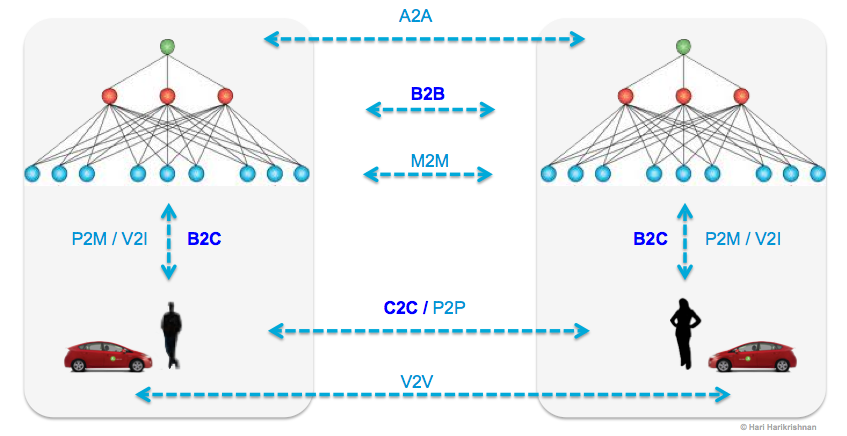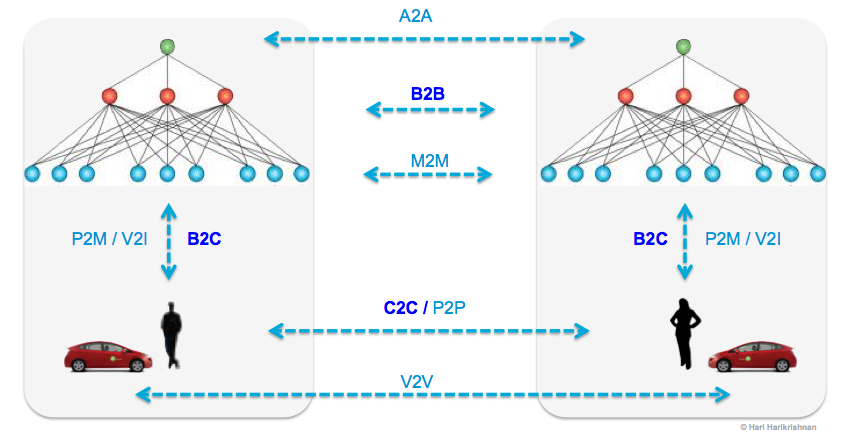Ever since my car got heated seats, every winter I wish that it would start to warm the seat 60 seconds before I got in the car. What if I could press a button on my App and tell the car while I am walking from my office to the parking lot! The car not only heats the seats, but based on my location picks a likely destination on the navigation system. I want an IP address for my car. I also want an internet service for it. I have not asked my car if it prefers AT&T or Verizon, since it lacks an IP address to communicate with me.
This frivolous desire got me to think about which other possessions of mine I would want to have an IP address. It led me to Internet of Things (IoT) or Internet of Everything (IoE). I don’t believe that my desires result from some personal eccentricity. Let me explain why.
Networking It
We are well on our way to pervasively connect all things with a modicum of intelligence in them. We want to “talk” to them. We want them to talk to us. We want them to talk to each other without bothering us and do the needful. For example, why can’t my video surveillance system check who is at the door against my whitelist of trusted people and ask my door lock to open itself and let them in? Whether you like that level of autonomous decision-making or not, we are headed there. See below for how that world looks with its web of interactions between various entities, business, legal, or more abstract.

This is what I consider to be X2X, anything to anything, an interaction between entities. Let’s look at a few of the connections that exist or are being made:
- A2A: Application to application: Software programs (human logic translated to software code) talking to each other
- B2B: Business to business: Commercial entities transacting with each other
- B2C: Commercial entities talking to us
- B2X: B2B and B2C combined
- C2C: Each of us transacting with each other via paypal etc. Or is it Cloud to Cloud?
- M2M: Machine to machine: Inanimate objects talking to each other
- S2S: Server to Server; Service-to-Service?
- V2V: Vehicle to vehicle communication (in our near future), a form of M2M
- V2I: Vehicles to Infrastructure: my car finding the best route based on information from the cloud
There is much more here. If we tabulate it all, there may not be many characters in the alphabet that do not talk to each other. It is exhausting to think about all that chatter, but all that chatter is useful. I might get warm seats in winter without a torturous minute of frosty seats.
Network of Entities
As I noted in the post on virtual social network of humans and its potential to bring about change, pervasive connectivity brings exciting possibilities. We can sense the possibilities. Imagine if every piece of intelligence that is out there is networked, regardless of however rudimentary as a door knob sensor or however advanced as a modern enterprise with its teeming masses of employees and systems it is. Such a Network of Entities (NoE) is not difficult to imagine, given the state of 21st century technology and business models. Each entity will need to publish an API (“Application Programming Interface” — nerdspeak for “here is how to talk to me and this would be my response if you talked to me that way”) so that it can talk or be talked to. Each entity provides a service that is available via an API. I can’t wait for the realization of what such a network of entities will do to humankind.
My car is screaming to be part of this X2X world. It can offer more services than it does today. It does not need a performance upgrade (6 cylinder, 300 Horse Power is more than good enough to go grocery-shopping!). It will need an API. However, it needs an IP address first…and a software upgrade.


IPV6 is designed for this very purpose. the whole idea, is that at some point each and every device will have an IP address. I think we are all headed in the direction of having everything networked, the main question is going to be security. IPV6 has the potential to have everything available on the public internet. So protecting access to all the devices is going to be the challenge.
Good point…we will have to rethink security not traditional terms of traditional firewall, intrusion protection etc, but in terms of exposing granular APIs and controlling access to the “service” offered by the entity via API access policies.